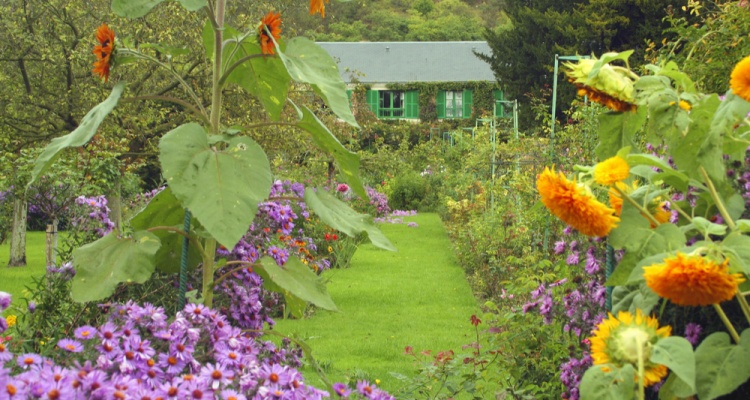With its mix of cobblestone and asphalt streets and its soot-dusted, zinc-roofed buildings beneath the usual lid of clouds and smog, Paris, the City of Light, is, admittedly, a gray place. Though its pewter cast may help ease you into a more contemplative state of mind as you saunter along the Seine, or inspire you to photograph the city in Henri Cartier-Bresson style, sometimes you just want to add some color to your stay there. One good way to get plenty of it is to see Monet’s flower and water gardens.
You can do so by visiting his former estate in Giverny, just outside the city, where you can enjoy these two gardens in bloom, and by visiting some very special museums in Paris where you can reflect upon the many luminous paintings he made of them. It’s also the perfect, if not the only, chance to see one of the great muses of the Father of Impressionism and the masterpieces it inspired him to create. So, let’s first visit the gardens and then we’ll hit the museums.
By the way, there are costs to enter the gardens in Giverny, and, of course, to access Paris’ museums, but compared to, say, shopping the Champs-Elysées, they’re cheap. Flights to Paris can still be had even at this time of the year so pounce!
Wander in a One-Time Painter’s Paradise in Giverny
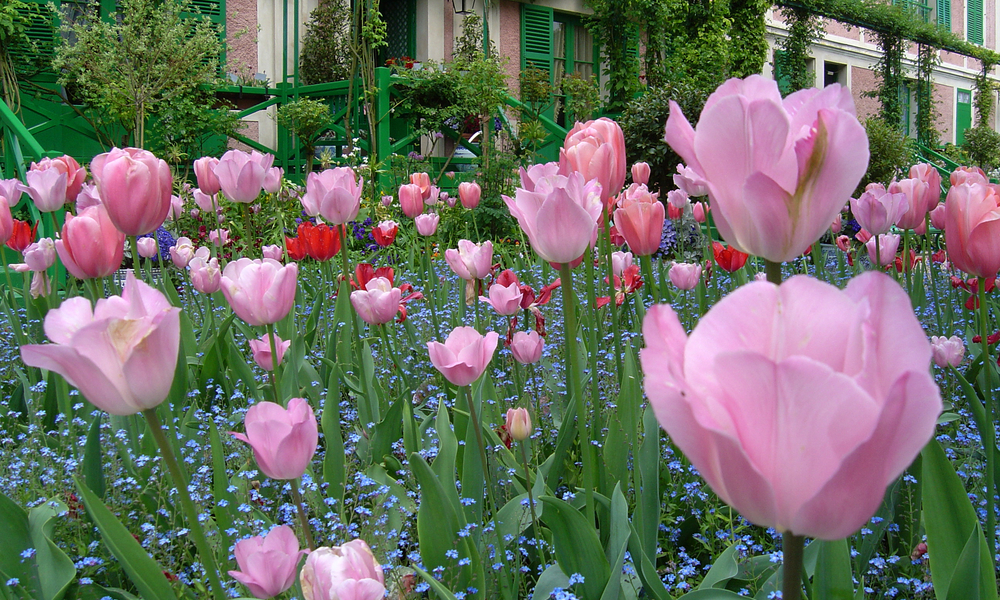
Springtime in Monet’s flower garden. / Photo by Francoise Legeard for Shutterstock.
There are gardens that are simply gardens; gardens that painter’s make paintings of; and then there are gardens that artists grow for the purpose of painting masterpieces. These latter ones are perhaps the most special of all, being carefully shaped by the artists’ aesthetic tastes, by their ideas on art and horticulture, by their obsessions, and often by their own hands. They are muses of the artists’ own making and havens where they can push the boundaries of their art. Monet’s flower and water gardens were such a paradise for him.
[perfectpullquote align=”full” bordertop=”false” cite=”” link=”” color=”” class=”” size=””] As you explore Monet’s paradise then, you’ll share in his passions and obsessions. [/perfectpullquote]
One of his lifelong loves was of course flowers. They were a seemingly endless source of inspiration for his painting and gardening, which he also did from a young age. “I must have flowers, always and always,” he said. Not unexpectedly, he also said “Color is my daylong obsession, joy, and torment.” And so, Monet created a large garden filled with thousands and thousands of brilliantly colored flowers in place of the apple orchard in the front of his house at Giverny. With its creation, landscapist had also become landscaper, molding the land to his artistic vision, which he would, after a time, render in oil paint on canvas.
Called the Clos Normand (or enclosed Norman garden), it ranges over 2 acres and is, despite its wild look, organized on a rectilinear plan. It has many narrow paths called alleés and one central Grand Alleé, framed in arches of richly colored flowers, that runs from the garden’s front gate to the front door of the house. You won’t find any byzantine or rococo hedges, topiaries, variegated plants (he hated them), or many garden fixtures as you stroll through it. There aren’t many directional signs either. (The better for wandering!)
[perfectpullquote align=”full” bordertop=”false” cite=”” link=”” color=”” class=”” size=””]Just bed after bed of glorious flowers and the alleés that lead you to vivid surprises within them.[/perfectpullquote]
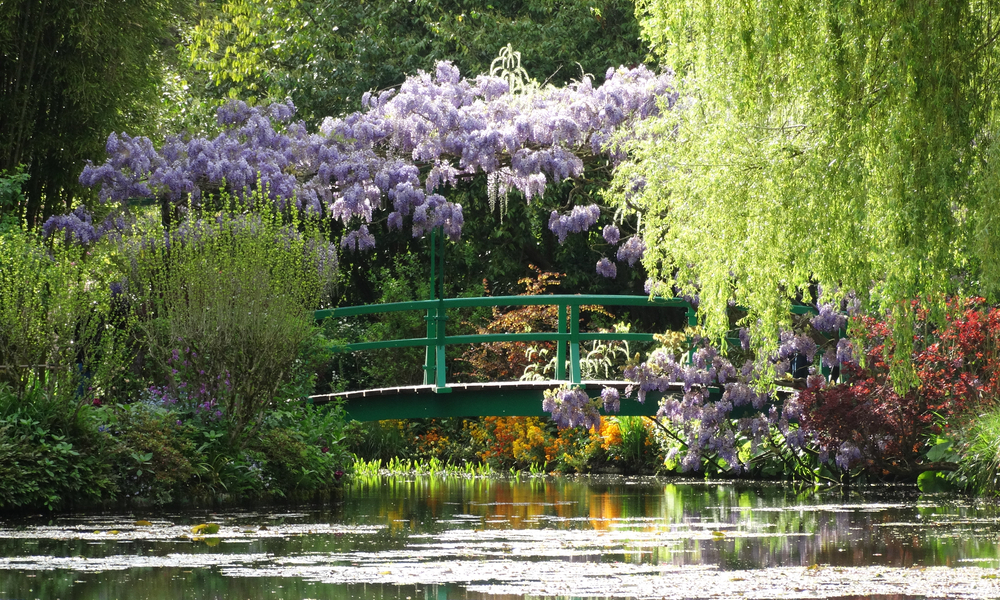
Purple haze: The wisteria-canopied Japanese footbridge in Monet’s water garden. / Photo via Shutterstock.
Fascinated with the play of light on water and enamored of Japanese art as well, he created a Japanese-themed water garden across the low road that runs past the front gate of the Clos Normand. A dreamy medley of green and blue hues accented by the yellow and pink flowers of water lilies, this garden makes a beautiful contrast, a world of its own where you can easily forget about the world.
[perfectpullquote align=”full” bordertop=”false” cite=”” link=”” color=”” class=”” size=””]One where water lilies take center stage as you gaze into the pond from a Japanese-inspired footbridge.[/perfectpullquote]
Needless to say, both gardens are quite special. You don’t have to worry about deciding which one to see first though as the layout of the estate kind of decides for you. Whether you enter through the main entrance near his house on Rue Claude Monet, which is the high road inside the village, or through the group entrance on Ruelle Leroy near the low road just outside the village, you’ll find yourself in the Clos Normand. (Individuals with online tickets should enter via the group entrance.) So, let’s go in!
Drink in the Neon Nectar of the Sun-Kissed Flowers
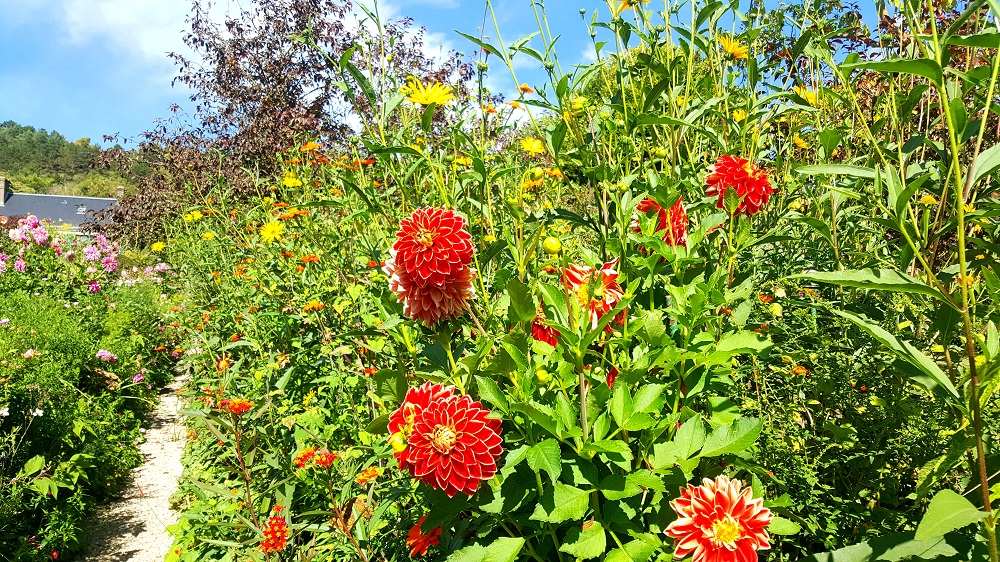
Dahlia…ghtful! / Photo by Joseph Decibus. All rights reserved.
On a sunny day, as you walk into the Clos Normand on one of its long alleés, you can feel the flowers crowd around you in ticklish embrace as if you were an old friend. They greet you with a radiance fit for a royalty. Magically, they melt away that heavy armor you have to wear each day against the slings and arrows of the world, leaving you defenseless to their many charms.
“Just look at those day-glo dahlias.” “Check out these over-the-top sunflowers.” “Whatever are those crazy purple rod-like things?” A few things you’ll say or hear said along the way. And so it goes, as you go down the alleé through the dazzling show of floral fireworks – bright pops, starbursts, shoots, and sparkles of color surrounding you. As you turn this way and then that, it’s a dizzying spectacle in which you sometimes feel like you’re trying to walk on a balance beam in the middle of a super soaker paint gun battle.
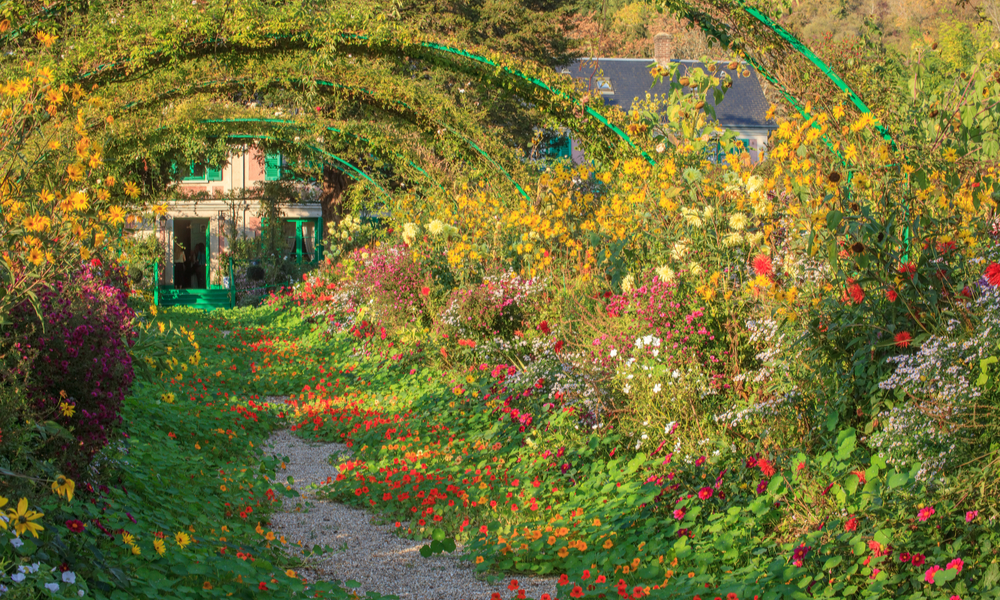
Monet’s nasturtiums blaze a scarlet and tangerine path along the ground in middle of the Grand Alleé in the Clos Normand. / Photo via Shutterstock.
The kinds of flowers that you’ll see depend upon when you visit. In spring, the mauve wisteria canopy over the Japanese footbridge is divine, and in early fall, you can enjoy Monet’s beloved red and yellow nasturtiums.
[perfectpullquote align=”full” bordertop=”false” cite=”” link=”” color=”” class=”” size=””]They do a fiery little paso doble in the Grand Alleé to the admiration of an audience of dahlias and asters, not to mention us tourists. [/perfectpullquote]
Float Away on the Cool, Green Lily Pads
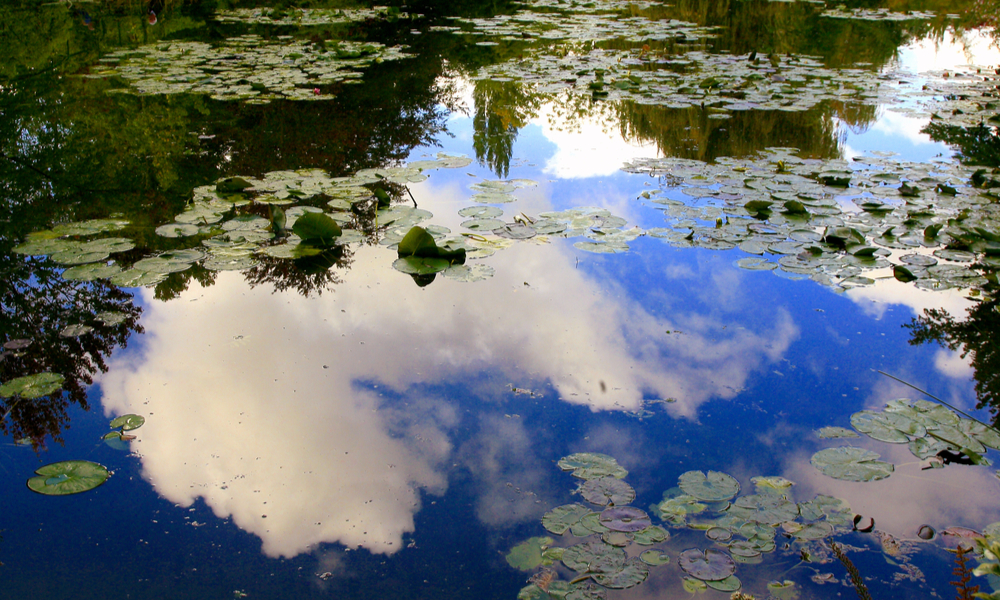
A transfixing swirl of clouds and lily pads in Monet’s Japanese water garden. (How did Monet ever get any painting done?) / Photo by Eric Valenne via Shutterstock.
There’s little shade in the Clos Normand as most of the trees are ornamental ones such as Japanese cheery and apple along with a lime tree or two. So, when you want to cool off, just head into the water garden. There’s a pedestrian underpass in the southwestern corner of the Clos Normand that goes under the low road and leads you right in. As you go through it, you’ll have that Alice-in-Wonderland feeling of falling down the rabbit hole and winding up in a very strange new world. For the Japanese themed water garden is so idyllic, so lush and dreamy, so serene, that you expect a nymph or at least a geisha to pop out and greet you.
Unlike the Clos Normand, the water garden is circular, a series of radiating rings beginning with a lily pad, then clusters of lily pads, then the pond, and then the path around the pond.
[perfectpullquote align=”full” bordertop=”false” cite=”” link=”” color=”” class=”” size=””]Ripples of blue-green to relieve your flower-fevered mind.[/perfectpullquote]
Gazing into the water then, you can easily become entranced watching the lily pads and clouds floating together in its mirror surface, the Clos Normand almost forgotten.
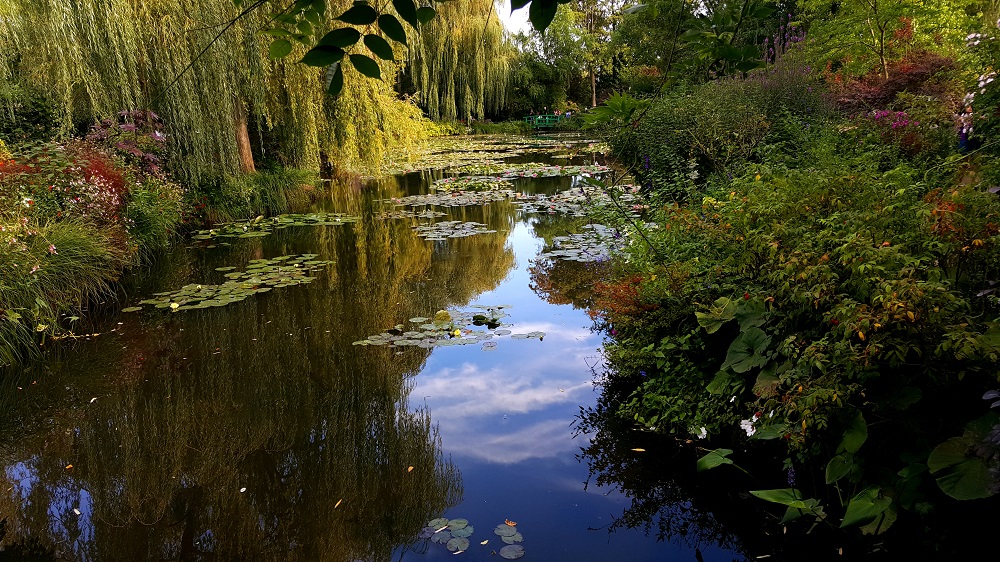
In the Japanese water garden, the weeping willows only ever weep for Monet. / Photo by Joseph Decibus. All rights reserved.
The melancholic weeping willows give the water garden a poignant, haunted beauty that seems to deepen at day’s end when it appears to be plaintively waiting for Monet to return. And for all we know, maybe he does. Maybe, on certain moonlit evenings, when the willows shimmer irresistibly in their moon-sequined beauty, the wind whispers “Monet, Monet” in secretive call.
And along he comes, gliding in on the stream in his floating studio to revisit his muse as all great artists who’ve passed on must surely be fated to do. Led by the moonbeams, his eyes twinkling in the glowing garden, he slips in as silently as the eel grass swims in the cool current, paint brush and palette eagerly in hand. A procession of geisha welcomes him home, click clacking across the footbridge in clogs with impending cadence; peeking over spread hand fans with ghostly faces; fluorescing in silk kimonos like the most exotic of fireflies.
[perfectpullquote align=”full” bordertop=”false” cite=”” link=”” color=”” class=”” size=””]Such a vision…could send the wisteria into hysteria. Such is the bewitching aura of the water garden. [/perfectpullquote]
Say Au Revoir to the Gardens from Monet’s Bedroom Window
No visit to the gardens is complete without touring the house where Monet lived. Just return to the Clos Normand, walk up an exterior alleé and go in. (Entry is included in the price of admission.) With its pastel pink façade accented by apple green window shutters and bedecked with merry garlands of ivy and with its brightly painted interior rooms, the house feels like an organic part of the garden.
The dining room, for instance, is almost entirely painted a buttery yellow so that when you step into it you feel as if you’re inside the flower of a yellow tulip. That Monet appreciated this harmony is evident in paintings he made of the flower garden in which his house appears barely distinguishable from it.
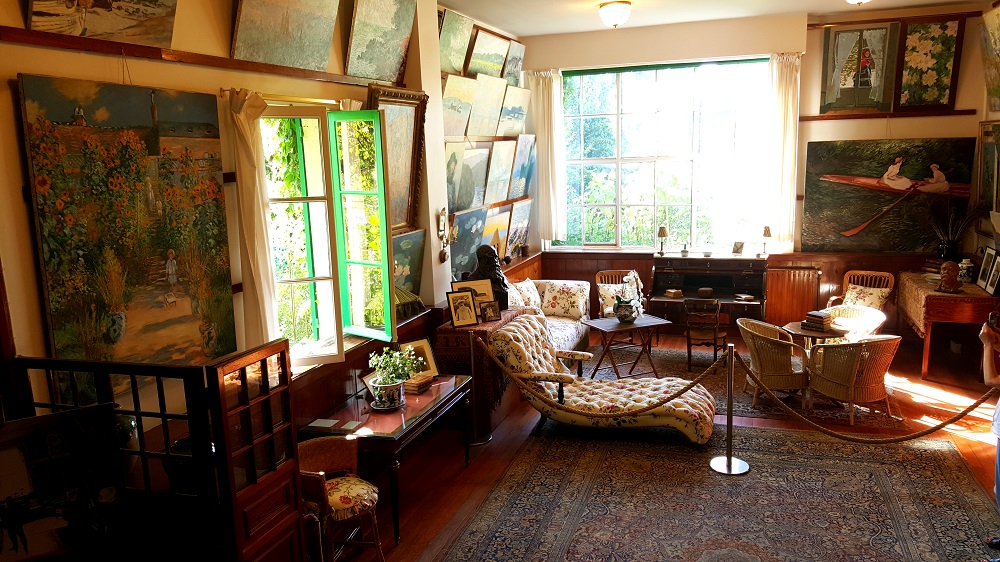
Monet’s comfortable sunlit studio in his house in Giverny with a window open on the Clos Normand. / Photo by Joseph Decibus. All rights reserved.
You’ll see copies of paintings by Monet and other major artists who were his friends as well as his beloved Japanese woodblock prints on the walls of many rooms, especially his studio. Though they’re copies, it’s wonderful to see the kind of art the Monet family lived with.
On the second floor you can walk through the bedrooms, including Monet’s. As you would expect, it overlooks the Clos Normand. From it, you can take one last, long special look at this garden through its tall windows, imagining, as you do, the joy that Monet must have felt waking up to his flowers each morning and in bidding them goodnight when he retired for the day, wondering, at times, if he would be able to return to them after he passed on.
[toggler title=”When to Visit” ]Spring and early summer are ideal times to visit since this is when the gardens are in peak bloom. Attendance also peaks then too so expect lots of company. Going in early September is perhaps a nice compromise where you sacrifice seeing the most robust blooms for a chance to linger longer with the flowers that are there then. See the Claude Monet Foundation for the specific time and costs of admission.[/toggler]
[toggler title=”Getting There” ]Though Giverny is 50 miles outside Paris, getting there is easy. Just hop on a TGV from Gare Saint-Lazare in the 8th arrondissement that goes to the Vernon-Giverny stop. It’ll have you in Vernon in about 45 minutes. (Leaving from this station is always an auspicious start since Monet made it famous in his paintings.) Purchase your ticket in advance on the SNCF website, which will email a scannable train ticket to you in a PDF file. From the Vernon train station, you can take Le Petite Train Givernon or a full coach shuttle to the gardens in Giverny, which takes an additional 20 minutes.[/toggler]
Reflect on Monet’s Paintings of His Gardens in Paris’ Museums
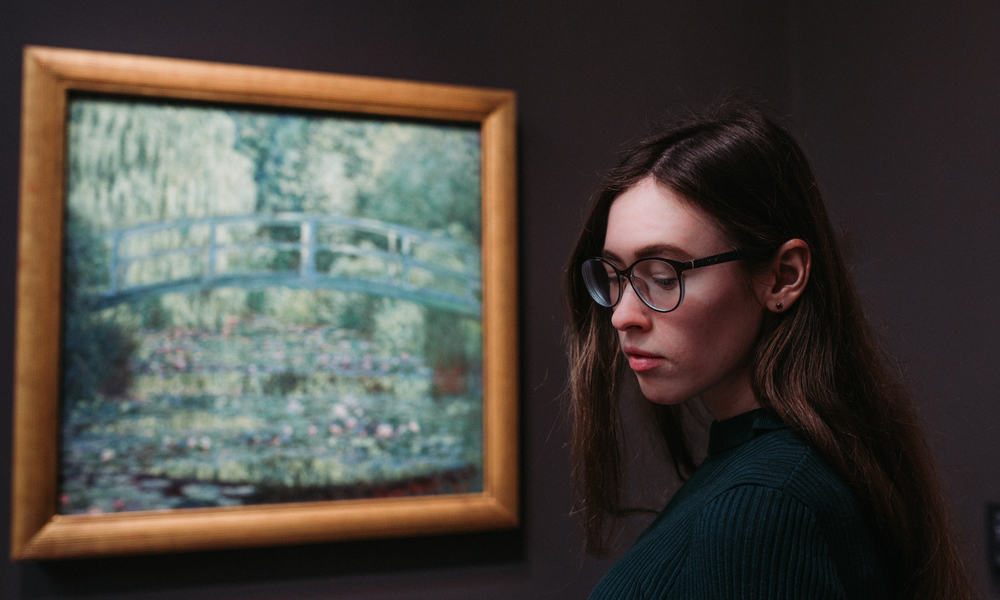
The pleasures of reflecting on Monet’s paintings are many. / Photo via Shutterstock.
It would be ideal, if not just, to have some of the paintings that Monet made of his garden on permanent display in Giverny at The Musée des impressionnismes, for instance, which is a short walk from his estate, but then life would have to arrange itself perfectly, which it rarely does, especially when it comes to art. Instead, most of his works, somewhat ironically, ended up in a few fine museums in Paris, a city that mostly laughed at Monet when he first attempted to exhibit his innovative paintings there in the 1860s. (Had the Musée des impressionnismes been around in Monet’s time or that of his son Michel, both of whom bequeathed or otherwise gave many paintings to the Paris museums, things no doubt would be different.)
So, here then are some highlights of three museums in Paris where you can enjoy seeing Monet’s paintings of his gardens.
The Musée Marmottan Monet Boasts ‘The World’s Biggest Collection of Works by Monet’
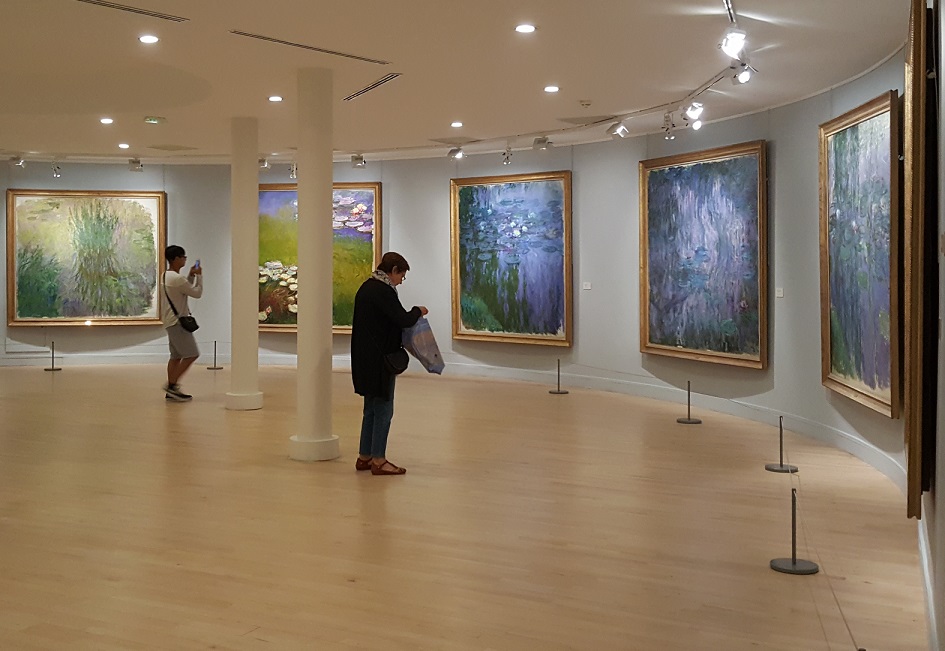
At the Musée Marmottan Monet, which is off the beaten path, you can have the Nymphéas practically all to yourself. / Photo by Joseph Decibus. All rights reserved.
This museum is in a converted townhouse that once belonged to the late Paul Marmottan, a prominent French businessman and influential art collector who, ironically, rejected the Impressionists. And it’s run by the Académie des Beaux-Arts, which, comically, in hindsight at least, joined Marmottan in rejecting them.
Despite its less than friendly past and paradoxical name, the Marmottan Monet now brims with important works by many Impressionist masters. When it comes to Monet’s art, you can see a unique ensemble of large-format water lilies among a nice range of his paintings. You’ll also find the original works of art that graced the walls of his estate in Giverny here.
[toggler title=”Getting There” ]The Marmottan Monet is located at 2 rue Louis-Boilly in the elegant 16th arrondissement just off the lovely Le Jardin du Ranelagh, which is a good park for a picnic. Take the Paris metro line 9 to the La Muette stop. Turn left when you come up out of the subway and walk west along Chaussée de la Muette past Restaurant La Gare to Avenue du Ranelagh. Follow it through the park until it ends at Avenue Raphaël. Turn right onto Avenue Raphaël and follow it for about a half block to Rue Louis-Boilly, the first street on your left and you’ll see the museum. It’s a nice 15-20-minute walk. Check the museum’s website for hours and ticket prices.[/toggler]
The Musée d’Orsay also Claims to Have ‘The Largest Collection of Works by Monet’
Only in Paris do you find two museums that each claim to have the most Monet paintings. Though it’s surely a point of pride for them, both have equally stellar collections in our view, and we’re quite happy to enjoy the embarrassment of riches as you will be too.
Located in a converted Beaux Arts railway station that is itself a work of art, the Musée d’Orsay hosts a diversity of types of art from painting to sculpture to architecture to graphic arts and more. If you can resist the temptation of Auguste Rodin’s Gates of Hell (Porte de l’Enfer) on the main floor, and if you don’t get too absorbed with Vincent van Gogh’s works on the median level, then you should be able to ascend to the museum’s highest floor where you’ll find the Monet paintings among those of other Impressionists.
Just as at the Musée Marmottan Monet, you can see a nice range of Monet’s themes and styles here. You can see some terrific paintings of the Clos Normand, such as Artist’s Garden in Giverny (Le jardin de l’artiste à Giverny), which depicts it almost as a jungle of vibrant color, and of the water garden as well such as Water Lily Basin, Pink Harmony (Le Bassin aux nymphéas, harmonie rose).
[toggler title=”Getting There” ]The Musée d’Orsay is at 1 Rue de la Légion d’Honneur, which is on the left bank of the Seine river. Take the Paris metro line 12 to the Assemblée Nationale stop. Walk east on Rue de Lille and you’ll reach the museum in about 5 minutes. See the Musée d’Orsay’s website for hours and ticket prices. [/toggler]
At the Musée de l’Orangerie, It’s Water Lilies Ad Infinitum
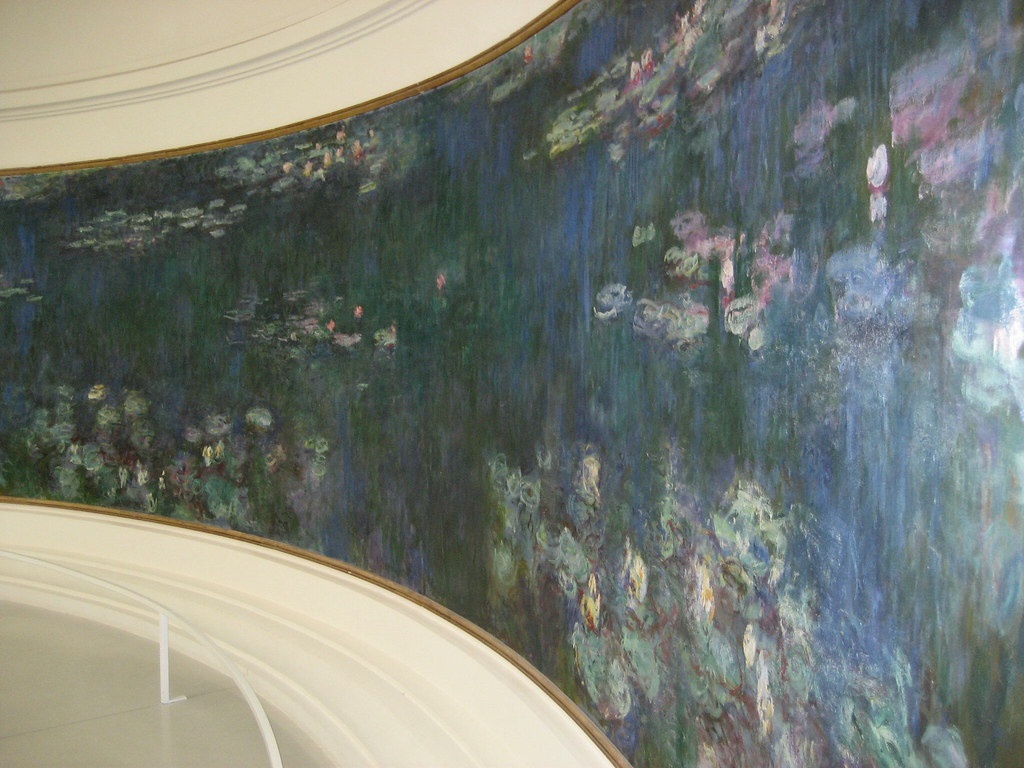
Monet’s water garden in Musée de l’Orangerie. / Image via Flickr – CC BY-SA 2.0 – Stephen Carlile
Water lilies to infinity, water lilies forevermore. This is at least one of the beautiful lines of the lyrical vision of his water garden that Monet gives us in an extraordinary set of eight large format panels from his Nymphéas series that are displayed in this jewel box of a museum by the Seine river. Curvilinear, the panels form a dramatic panorama of the pond on the walls of two consecutive oval rooms, which together evoke the symbol of infinity. The rooms were specially designed for them by Monet. It can be quite challenging, quite an emotional experience indeed, to try to wrap your mind around them as they wrap around you. Though it’s all of Monet that you’ll get here, it’s all you need, for to look upon this work of art is to float.
[toggler title=”Getting There” ]The Musée de l’Orangerie is in the Jardin des Tuilleries near the Place de la Concorde on the right bank of the Seine. Take the Paris metro line 1, 8 or 12 to the Concorde stop. Walk south towards the river until you get to the museum’s entrance. See the museum’s website for hours and ticket prices. You can buy a combination ticket that includes the Musée d’Orsay as well.[/toggler]
[perfectpullquote align=”full” bordertop=”false” cite=”” link=”” color=”” class=”” size=””]What’s your favorite garden? Let us know in the comments.[/perfectpullquote]
[Feature photo: A view of Monet’s house in Giverny from the Clos Normand. / Photo via Shutterstock.]
Note: In addition to the websites of the museums mentioned here and that of the Claude Monet Foundation, the following resources were helpful in the creation of this post:
Monet’s Years at Giverny, Beyond Impressionism by Daniel Wildenstein and published by the MET.
How Monet’s Garden Grew by France Today Editors
The Art of Monet’s Garden by Country Life

